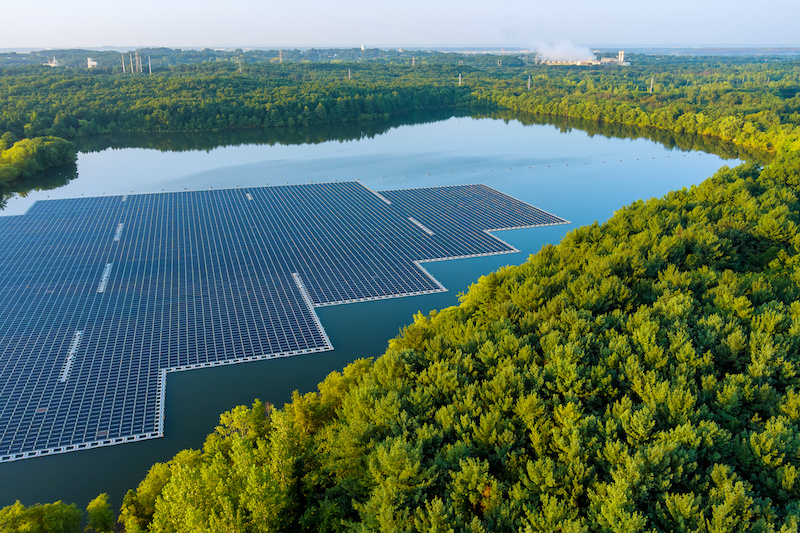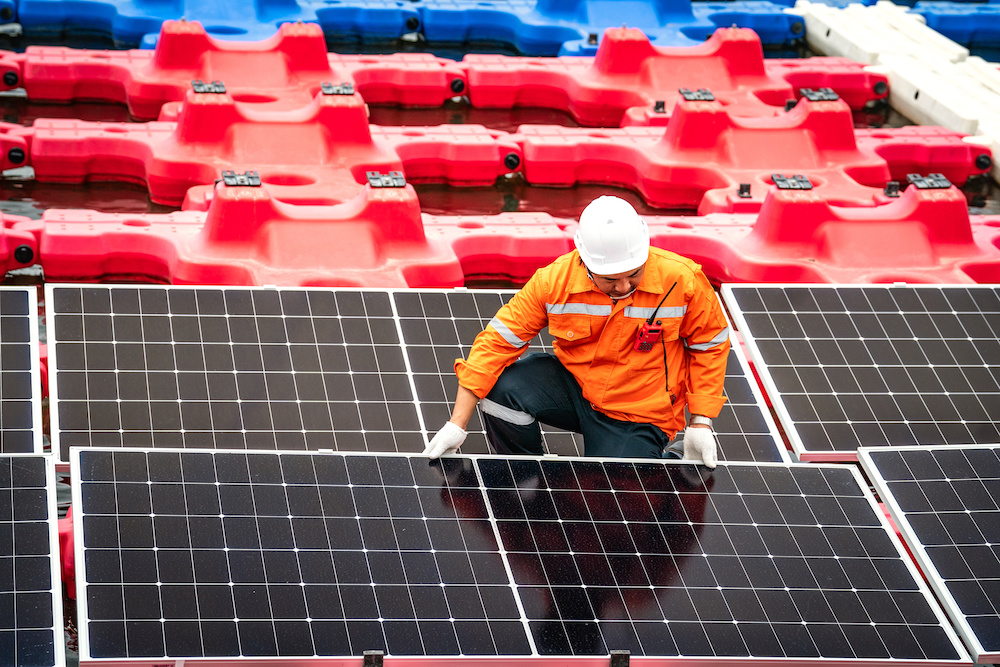
Find out what solar panels cost in your area
Floating solar panels, also known as floating photovoltaic panels (FPV), use mounting that is designed specifically to rest on calm, stagnant bodies of water. Unlike traditional solar panel installations, FPV installations can be placed right on lakes or water reservoirs instead of affixed to roofs or ground mounts.
Floating panels are not yet fully utilized in the United States, there are only a few of them in operation. Globally, they are embraced as large-scale solar projects and offer opportunities for solar energy generation in unique places.
Within this article, we will discuss what makes floating solar panels different from traditional panels, where you can find examples around the world, and their pros and cons.
Key takeaways
-
Floating solar panels offer enormous potential within the U.S., with the ability to generate 10% of the county’s electricity if installed in each available body of water.
-
Floating solar panels help keep bodies of fresh water clean while generating renewable electricity.
-
Installing floating solar panels is becoming increasingly popular throughout the U.S. but it is already widely used around the world.
How are floating solar panels different from traditional panels?
Although traditional solar panels have been in use for decades, the first floating solar array was installed in Japan in 2007. Because the technology is fairly new, the economic benefits of floating solar and the arrays’ ability to last is challenging to calculate. But early adopters of the technology are already seeing benefits in savings.
Surprisingly, solar panels that are built to be used on land can also be used in floating solar panel arrays. Instead of traditional metal racking, these solar panels float above the water on hollow plastic buoys that are designed to withstand extreme weather conditions. Cables help anchor the panels in place and deliver solar power to land to be converted to electricity where it is needed.
Really, the largest difference between traditional solar panels and floating panels is the way they are held together. Traditional panels use racking to either be secured to roofs or the ground, while floating solar panels are secured in place on top of water.
Where are floating solar panels in use today?
Many floating solar farms are in Southeast Asia because of the relatively small availability of dry land there. Asia as a whole has been quicker to embrace floating solar panel technology, and the largest floating solar panel farm, built by the French Company Ciel & Terre, is in China. The solar array is a total of 70 megawatts (MW) and was built on an artificial lake that was created on a former coal mine.

Image: golfloiloi - stock.adobe.com
Within the U.S., the first installation of floating solar panels was at the Far Niente winery in California. Because land is expensive and a winery needs as much land as it can get to produce grapes, making space for solar panels was not ideal. But, there was a pond that could afford to be put to use - enter, floating solar panels.
With the goal of reducing electricity bills while saving land, a floating solar panel array was installed. The installation was a bit of trial and error but it served as inspiration for the current largest floating solar panel array in Sayreville, New Jersey.
One of the unique features of the 4.4 megawatt floating solar array in Sayreville, NJ is that it is built over the town’s drinking water treatment center. The solar panels help protect the water by reducing algae growth and evaporation by keeping the water cool and shaded.
This is a great opportunity for water treatment plants around the country. If putting solar panels on the water that is already there has no negative effect on the process of cleaning and using that water for the town, it is a win-win situation.
Although installing floating solar PV is relatively easy and there is ample opportunity to install within the U.S., it is expanding slowly. But, if floating solar panels were installed on all man-made bodies of water in the U.S., they could generate 10% of the country’s annual electricity consumption, according to the National Renewable Energy Laboratory (NREL).
The pros even outweigh the cons, as noted below, so the future of floating solar panels within the U.S. could be bright.
Pros and cons of floating solar panels
Floating solar panels offer enormous potential for renewable energy energy generation and the advantages greatly outweigh the potential downsides. Take a look at the top pros and cons of utilizing floating solar panels:
Pros | Cons |
|---|---|
Helps improve water quality | Higher maintenance cost |
Water cools solar panels, increasing efficiency | Adverse effects from water |
Can be utilized at current power plants | Potential to disturb aquatic life |
Does not use scarce land |
Pros of floating solar panels
Helps keep the water clean
The best place to install floating solar panels is on stagnant fresh bodies of water like lakes or ponds. Fresh water has a high potential for growing excessive amounts of algae that can damage local wildlife by depleting oxygen from the water, and the panels serve as a deterrent.
Climate change heats up water which then allows algae from pollutive sources to proliferate. But, with floating solar panels covering the water, they help keep it cool, reducing the potential for algae blooms.
Water cools the panels, increasing efficiency
Solar panels absorb extreme amounts of heat and when they get too hot, their efficiency begins to decrease at a rate known as the temperature coefficient. But water has a cooling effect on the panels, increasing their ability to absorb sunlight and convert it to energy.
Can be installed at existing power plants
Most hydropower plants are built with a dam that stores excess water that then creates an artificial lake, like Lake Mead in Nevada. These lakes offer a great opportunity for floating solar panels to rest on the surface - combining two clean energy sources at once! These panels can then take advantage of the existing cables that send electricity to the grid from the hydroelectric plant that is also already there.
Does not use scarce land
A challenging selling point for large solar farms is the amount of space they need to take up, especially if land is scarce and expensive. Using existing bodies of water instead can eliminate this barrier. While we can’t put solar panels on every open source of water, it is an opportunity that should be expanded on.
Cons of floating solar panels
Higher maintenance costs
Because floating solar panels are a relatively new concept, especially within the U.S., maintenance costs are higher because so few professionals have experience with maintaining the floating structures. But, the price issue might soon be a thing of the past as more floating solar panel arrays are installed within the U.S.
Solar panels can be affected by water
Solar panels are built to be waterproof to withstand the rain, but exposure to water 24/7 might have an adverse effect on the panels. Any panels that break would be exposed to more damage from water. But this potential downside is hardly a cause for not installing floating solar panels.
Potential to disturb aquatic life
While this issue is not yet conclusive, there is potential for the solar panels to disturb aquatic life because it blocks the sun from reaching the entire water surface. Also, the panels and equipment to secure them can pose risks for animals who do not know what they are or take space away from their habitat.
The potential environmental impact on fish and other water dwelling animals is perhaps the most negative aspect to floating PV systems. But, if floating solar panels are built on man-made lakes and reservoirs, these locations are not especially diverse with wildlife when compared to a natural lake, so they are a good spot for floating solar panel installations.
What is the potential future of floating solar farms in the US?
Floating solar arrays offer huge potential within the U.S. In 2019, the U.S. installed only 1% of the world's floating solar panels, compared to Asia which installed 87% of global floating solar panels.
As noted above, if all 24,000 artificial lakes, ponds, and reservoirs within the U.S. installed floating solar panels, we could power 10% of the country’s electricity. All of this without using up valuable land that can be used for other purposes, like farming, development, or simply land that is left natural for the benefit of capturing carbon emissions from fossil fuels.
Projects are popping up throughout the U.S. and a recently announced project at Fort Bragg in North Carolina will be the largest in the Southeast and first floating solar panel array built by Duke Energy.
Building a floating solar panel system at such a prominent location and by a well-known company points to the growing interest in floating solar projects. And with promising clean energy initiatives from the Biden Administration, floating solar panels might become the next exciting project in the solar industry!
Does floating solar make sense for homeowners?
Unfortunately, floating solar panels do not make sense for most homeowners. Unless you have access to your own lake or pond, rooftop solar panels are your best bet. But the good news is that there are many experienced installers to choose from who can help you install the perfect solar panel system for your home.
Work with a local solar installation professional today to help you save money with solar! Similar to an unused pond, your unused roof space is the perfect spot to put panels to use for your own power generation.
Ana is the Marketing & Communications Manager at SolarReviews, working within the solar industry since 2020. With a Master's in Climate and Society and professional experience in marketing, she helps communicate the value of solar to homeowners and build awareness of the SolarReviews brand. On weekends you can find her at the Jersey shore, reading a book from the ever-increasing stack on her side table, or eating food someone else cooked....
Learn more about Ana Almerini